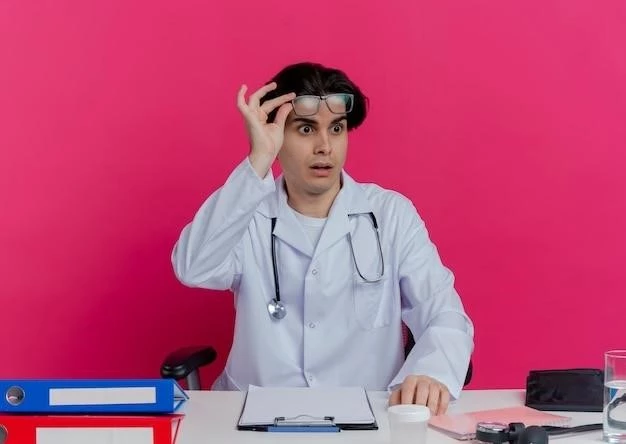Understanding Hypertropia
Understanding Hypertropia is crucial for proper diagnosis and treatment․ Learn about the causes, symptoms, and treatment options available․ Seek advice from an optometrist to address any misalignment in the eye muscles․
Introduction
Welcome to an informative guide on understanding Hypertropia, a condition characterized by misalignment of the eyes․ Hypertropia, commonly known as vertical strabismus, can affect individuals of all ages, leading to issues with eye alignment and vision․ In this article, we will delve into the causes, symptoms, diagnosis, and treatment options available for this eye condition․ By gaining a deeper understanding of Hypertropia, you can take proactive steps towards managing and improving your eye health․ Remember, early detection and intervention are key in addressing eye conditions effectively․
Understanding Hypertropia
Hypertropia is a type of strabismus where one eye is vertically misaligned in relation to the other eye․ This misalignment can cause one eye to point higher than the other, leading to double vision and visual disturbances․ The condition can affect individuals differently, with some experiencing intermittent symptoms while others may have a constant eye deviation․ Understanding the mechanics of how the eye muscles work together for proper alignment is essential in grasping the complexities of Hypertropia․ By learning about the causes and impact of this condition, individuals can make informed decisions regarding their eye health and seek appropriate treatment options to address any visual disturbances or discomfort caused by hypertropia․
Causes of Hypertropia
The causes of Hypertropia can vary and may be attributed to issues with the eye muscles responsible for controlling eye movements․ Some common factors contributing to hypertropia include nerve palsies, trauma to the eye muscles, thyroid eye disease, and certain health conditions like diabetes or myasthenia gravis․ In children, congenital abnormalities or genetic predisposition can play a role in the development of hypertropia․ Additionally, refractive errors or underlying vision problems can lead to strabismus and subsequent hypertropia․ Understanding the underlying causes of hypertropia is crucial in determining the most effective treatment approach to correct the misalignment and improve overall eye health․
Symptoms of Hypertropia
The symptoms of Hypertropia can manifest as a noticeable misalignment of the eyes, where one eye appears higher than the other․ Individuals with hypertropia may experience double vision, especially when looking in certain directions․ Eye strain, headaches, and difficulty focusing can also be common symptoms associated with hypertropia․ Children with hypertropia may exhibit behaviors like squinting, tilting their head, or closing one eye to compensate for the eye misalignment․ If you or a loved one are experiencing any of these symptoms, it is essential to consult with an eye care specialist for a comprehensive evaluation and appropriate management of hypertropia․
Diagnosis of Hypertropia
Diagnosing Hypertropia typically involves a comprehensive eye examination conducted by an optometrist or ophthalmologist․ During the examination, the eye care specialist will assess the alignment of the eyes, evaluate eye movements, and perform tests to check for any refractive errors or underlying conditions contributing to the hypertropia․ Specialized tools like prisms and cover tests may be used to measure the degree of eye misalignment accurately․ In some cases, imaging studies such as MRI or CT scans may be recommended to rule out any neurological issues affecting the eye muscles․ Early and accurate diagnosis of hypertropia is critical in determining the most appropriate treatment plan to address the eye misalignment and improve visual function․
Treatment Options for Hypertropia
When it comes to addressing Hypertropia, there are several treatment options available depending on the severity and underlying causes of the condition․ Non-surgical approaches such as corrective lenses, prisms, or eye patching may be recommended to help improve eye alignment and visual function․ Vision therapy, involving exercises to strengthen eye muscles and improve coordination, can also be beneficial in managing hypertropia․ In cases where non-surgical methods are not sufficient, surgery to adjust the positioning of the eye muscles may be considered to correct the misalignment․ It is essential to consult with an eye care specialist to determine the most appropriate treatment plan tailored to your individual needs and effectively address the hypertropia to enhance your overall eye health․
Surgical Correction for Hypertropia
Surgical correction for Hypertropia may be recommended in cases where non-surgical interventions have not effectively addressed the eye misalignment․ The surgery typically involves adjusting the positioning of the eye muscles to improve alignment and coordination․ During the procedure, the surgeon may weaken or strengthen specific eye muscles to achieve the desired alignment․ Surgical correction for hypertropia aims to enhance binocular vision and reduce symptoms such as double vision and eye strain․ It is crucial to discuss the potential risks, benefits, and expected outcomes of the surgery with your eye care provider to make an informed decision regarding the surgical intervention for hypertropia․
Corrective Therapy for Hypertropia
Corrective therapy for Hypertropia includes a range of interventions aimed at improving eye alignment and visual function without surgical intervention․ Vision therapy, involving specialized exercises and activities, can help strengthen eye muscles, enhance coordination, and improve binocular vision․ Prism lenses may be prescribed to assist in reducing double vision and aligning the eyes properly․ Eye patching or occlusion therapy may also be used to stimulate the weaker eye and encourage visual development․ It is essential to follow the guidance of your eye care specialist and adhere to the recommended corrective therapy plan to optimize the outcomes and effectively manage hypertropia․
Importance of Post-Surgery Care

After undergoing surgical correction for Hypertropia, post-surgery care is crucial to ensure optimal healing and visual outcomes․ Following the surgeon’s instructions regarding medication, eye care, and activity restrictions is essential for a successful recovery․ Attend follow-up appointments with your eye care provider to monitor progress, address any concerns, and assess the effectiveness of the surgical intervention․ Engage in recommended eye exercises and rehabilitation to promote eye muscle strength and coordination․ Protect your eyes from potential injuries and avoid activities that may strain the eyes during the post-surgery period․ By prioritizing post-surgery care, you can enhance the results of the surgical correction and achieve improved eye alignment and visual function․
Conclusion
In conclusion, understanding and addressing Hypertropia is essential for maintaining optimal eye health and vision․ By recognizing the causes, symptoms, and available treatment options for this condition, individuals can take proactive steps towards improving eye alignment and visual function․ Whether through non-surgical interventions like corrective therapy or surgical correction, seeking guidance from eye care specialists is key to effectively managing Hypertropia․ Remember to prioritize regular eye examinations, follow treatment recommendations, and prioritize post-surgery care to optimize outcomes and enhance overall eye health․ With proper care and intervention, individuals with Hypertropia can achieve improved eye alignment, reduced symptoms, and better quality of life through enhanced visual clarity and comfort․
